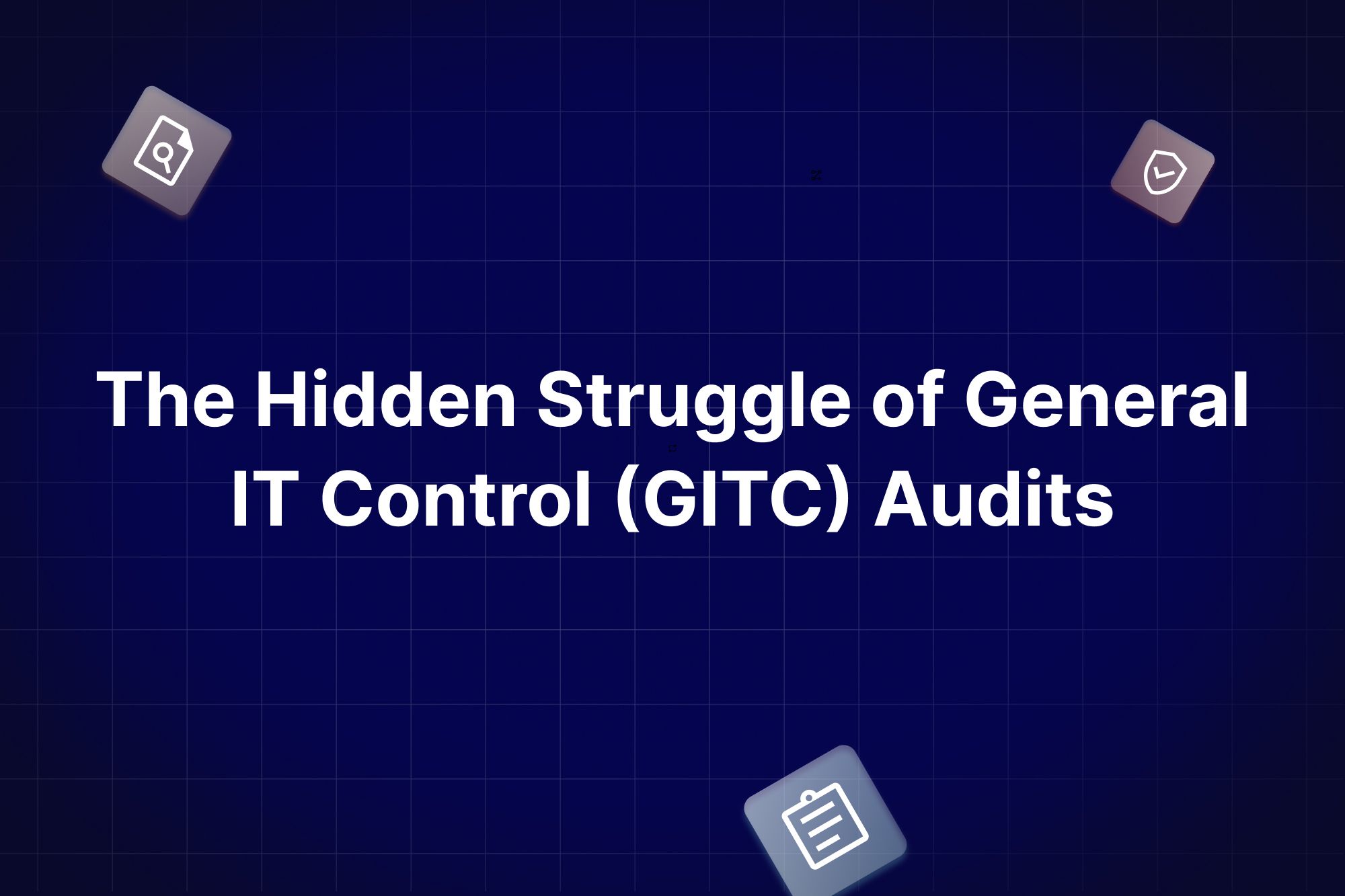The Hidden Struggle of General IT Control (GITC) Audits

Every GITC audit begins the same way: auditors requesting mountains of data that development teams scramble to manually export from GitHub, Jira, CI/CD systems, and other tools. What should be straightforward compliance becomes weeks of work verifying PR approvals, tracing code changes to requirements, and gathering scattered evidence. The irony is clear: engineering teams have automated software delivery, yet audit compliance remains tied to manual exports and spreadsheets. This post explores how modern teams can reshape GITC audits through automated, evidence-driven workflows that simplify compliance while strengthening development practices.
The Manual Audit Bottleneck
When auditors need to verify GITC controls, the process quickly turns into a massive data collection exercise:
- PR History: Exporting PR data across multiple repositories, tracking approvals, merge timelines, and identifying who merged what.
- Task Management Tracing: Linking Jira tickets to actual code changes and mapping developer workloads with cycle times.
- Cross-Platform Evidence: Collecting proof from GitHub, GitLab, CI/CD systems, and project management tools, each operating in silos.
The Traditional Five-Step GITC Audit Process
A GITC audit may sound straightforward, but in practice, it follows a detailed, step-by-step process. Each stage has its focus, deliverables, and expectations.
Step 1: Planning & Scoping
Auditors define audit boundaries, identifying in-scope systems, repositories, environments, and timeframes. They identify the relevant controls, such as change management, access permissions, segregation of duties, and deployment approvals.
What auditors ask for: system inventory, repository list, environment maps, and documented change policies.
Step 2: Control Walkthroughs
Auditors trace how changes move through development, from requirement to deployment. They validate access permissions, approval requirements, and enforcement gates.
What auditors ask for: workflow diagrams, role and permission matrices, sample Jira tickets and PRs, and CI/CD gate configurations.
Step 3: Evidence Collection
This stage collects concrete proof that controls were properly followed. Auditors gather PR approvals, review timestamps, build logs, deployment records, and exception justifications while verifying Jira-to-PR mappings.
What auditors ask for: PR metadata exports, Jira-to-PR linkage, pipeline execution logs, approval audit trails, and exception or override records.
Step 4: Testing & Evaluation
Auditors run sample tests to validate completeness and consistency, confirming required approvals, segregation of duties, and proper deployment gates. The system flags gaps, including force merges and missing links.
What auditors deliver: sample test results, exception lists, preliminary findings, and remediation requests.
Step 5: Reporting & Remediation
Auditors issue reports summarizing control effectiveness, highlighting deviations, and listing corrective actions. Teams track remediation to closure and prepare for ongoing monitoring.
What auditors expect back: corrected workflows, updated policies, and evidence showing that fixes are sustained over time.
How DevDynamics Steps In
Audits rarely fail due to missing controls; they fail because the proof of those controls is buried in endless exports and spreadsheets. DevDynamics closes this gap by making evidence easy to access, understand, and present.
Complete Data Integration
With over 20 native integrations, including Jira, GitHub, CI/CD systems, and PagerDuty, DevDynamics consolidates engineering data into a single source of truth. Everything is accessible in one place, including:
- PRs with full metadata: author, reviewers, approval timestamps, and merge history.
- End-to-end task lifecycle: from Jira ticket creation through to production deployment.
- CI/CD pipeline results: including exceptions, overrides, and failed runs.
- Developer activity insights: workload patterns and distribution across teams.
Ready-Made Audit Reports
Raw engineering activity is automatically converted into audit-ready reports aligned with GITC requirements, with built-in features like
- Pre-formatted evidence packages that showcase approval workflows and policy enforcement.
- Traceability matrices linking Jira requirements → PRs → deployments.
- Exception reports that highlight potential control failures early.
- Timeline visualizations that demonstrate clear segregation of duties.
Security-First by Design
DevDynamics is SOC 2 certified and engineered with a strict security model. It never touches source code; instead, it extracts only metadata and audit trails. Intellectual property remains protected, while compliance teams continue to receive the detailed evidence they need. This balance of transparency and protection is essential for modern engineering environments.
Process-Agnostic Integration
Audits should confirm how work is really done, not force teams into artificial workflows. DevDynamics adapts to existing team processes, capturing evidence from current tools. This ensures reports reflect what actually happened, not what policy documents say should happen, delivering reliable compliance without slowing operations.
What an Audit-Ready Package Looks Like
Instead of scattered spreadsheets and disconnected exports, auditors receive structured reports they can review immediately. A DevDynamics evidence package includes all the elements required to validate GITC controls, presented in formats that are easy to understand and act upon:
- PR Ledger: A consolidated record of each PR, including the author, reviewers, approvals, and merge timestamps. This creates a clear audit trail of how changes were reviewed and approved.
- Traceability Matrix: A complete mapping of Jira tickets to PRs, commits, builds, and deployments. This ensures every requirement can be traced through its full lifecycle from planning to release.
- CI/CD Compliance Snapshot: A history of build and deployment results, with exceptions and overrides flagged for visibility. This confirms that automated controls are functioning as designed.
- Segregation of Duties Timeline: A visual breakdown of who authored, reviewed, and deployed each change. This makes it easy to verify that responsibilities remain properly separated.
- Exception Log with Remediation Guidance: A record of unusual events such as force merges, skipped approvals, or policy bypasses. Each entry is paired with suggested remediation steps, helping teams address risks proactively.
- Export and Presentation Options: A set of formatted PDF packages for formal audit submission, CSV data exports for auditor analysis, and direct dashboard access for real-time evidence review. All data maintains audit-quality timestamping and accuracy standards while remaining centrally accessible throughout the audit process.
Outcomes You Can Measure
Automation delivers clear, measurable results:
- Evidence in Minutes: Collecting and organizing audit evidence shifts from weeks of manual work to just minutes.
- Fewer Errors, Faster Closeouts: Reducing missing or incorrect records accelerates audit closure and minimizes unnecessary back-and-forth.
- Better Everyday Visibility: The data that powers audits also enhances everyday visibility into metrics such as DORA and cycle times, enabling teams to maintain tighter control and drive continuous improvement.
Implementation Guide: Automating GITC Audits with DevDynamics
Getting your engineering team ready for GITC audits doesn't have to involve weeks of manual data collection. This step-by-step approach outlines how to automate audit readiness, replacing the pain of manual compliance with a streamlined, reliable process.
Step 1: Connect Your Engineering Ecosystem
Start by integrating DevDynamics with all platforms that auditors typically examine during GITC reviews. This comprehensive connection ensures that no audit evidence gets overlooked.
Core Integrations to Set Up:
- Source Control Systems: GitHub, GitLab, Bitbucket, Azure Repos
- Project Management Tools: Jira, Asana, Shortcut, Azure Boards, Linear
- CI/CD Pipeline Platforms: Jenkins, CircleCI, GitHub Actions, Azure DevOps
- Communication Channels: Slack, Microsoft Teams, Outlook, WebEx
- Development Tools: SonarCloud, Snyk, PagerDuty, Confluence, Google Calendar
How to Connect: Navigate to the Integration screen within DevDynamics and add each platform using secure OAuth or token-based authentication. The system automatically retrieves at least one month of historical data from each connected tool. For audits that demand extended lookback periods, the system retrieves older records on configuration.
This initial setup creates the foundation for comprehensive audit trail visibility across your entire development lifecycle.
Step 2: Enable Automated Data Centralization
Once integrations are active, DevDynamics begins aggregating engineering activity into a unified audit-ready format. The system automatically consolidates all development activity detailed in the "Complete Data Integration" section above into centralized dashboards, eliminating the need for manual data compilation.
This automated centralization process runs continuously in the background, ensuring audit evidence remains current and complete. Teams no longer need to scramble during audit periods to export and correlate data from multiple disconnected systems; the unified view is always available and ready for audit.
Step 3: Configure Audit-Focused Dashboards
DevDynamics provides purpose-built dashboards that surface exactly the way evidence GITC auditors request most frequently. Each dashboard addresses specific compliance requirements while remaining exportable for formal audit presentations.
Essential Dashboards for GITC Compliance:
- Git Dashboard: Displays reviewer distribution patterns, PR review rates, PR aging metrics, and cycle time analysis to highlight code review effectiveness.
- Ticket Dashboard: Shows issue throughput, cycle time distribution, open issue aging, and requirements mapping to demonstrate how development work aligns with business requirements.
- DORA Metrics Dashboard: Tracks deployment frequency, lead time for changes, change failure rates, and mean time to recovery to demonstrate the effectiveness of release management.
- CI/CD Pipeline Dashboard: Monitors pipeline health, execution logs, failed runs, and exception handling that confirms automated quality gates function properly.
- Code Quality Dashboard: Reports coverage percentages, duplicate code density, and test suite health that demonstrate development quality standards.
- Team and Contributor Dashboard: Provides segregation of duties verification, role matrices, activity logs, and individual contributor profiles that prove proper access controls.
Step 4: Implement Automated Policy Enforcement
Rather than relying on manual policy adherence, configure DevDynamics "Working Agreements" that automatically monitor and enforce your software development standards in real-time.
Key Policy Areas to Configure:
- Mandatory PR reviews before merging
- PR size limitations to ensure manageable code changes
- Segregated duties requirements separating development and deployment responsibilities
- Required approval workflows for different types of changes
Setting Up Enforcement: Set team-wide or organization-wide agreements in DevDynamics, enable automated notifications such as Slack reminders for pending reviews to keep processes on track, and monitor compliance through heatmaps and anomaly reports that clearly highlight areas needing attention.
Step 5: Generate Comprehensive Audit Evidence Packages
When audits begin, DevDynamics automatically generates a comprehensive evidence package, including the PR Ledger, Traceability Matrix, CI/CD Compliance Snapshot, Segregation Timeline, and Exception Log. The system handles all formatting, timestamping, and export requirements.
Step 6: Establish Continuous Compliance Monitoring
Effective GITC audit readiness requires continuous monitoring to maintain high-quality evidence and ensure control effectiveness throughout the year.
- Key Activities: Regularly review dashboard metrics for control gaps, update Working Agreements as policies change, track exception remediation, and prepare evidence packages quarterly.
- Benefits: This turns audits from disruptive events into routine checks. Teams maintain visibility into their compliance posture, while auditors receive current, comprehensive evidence rather than hastily assembled data.
Practical Implementation Tips
- Audit Period Configuration: Adjust data retention and retrieval settings to match your organization's audit requirements, whether annual, quarterly, or triggered by specific events.
- Team Segmentation: Configure team and sub-team structures within DevDynamics to enable audit evidence filtering by project, department, product line, or other organizational boundaries that align with audit scope.
- Contributor-Level Analysis: Leverage detailed contributor profiles to investigate individual compliance patterns and identify training opportunities or process improvements.
- Data Export Flexibility: Take advantage of comprehensive export capabilities to download any dashboard view or data table for integration with existing audit workflows or further analysis.
Conclusion
GITC audits don't have to be painful or time-consuming. With the right platform, proving controls is effortless, allowing teams to stay focused on building and improving systems. DevDynamics automates compliance evidence gathering, simplifying audits while strengthening everyday engineering practices. Book a quick walkthrough today and see it in action.

